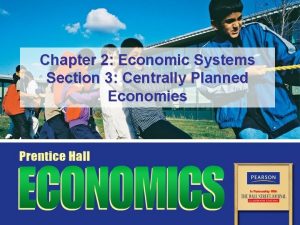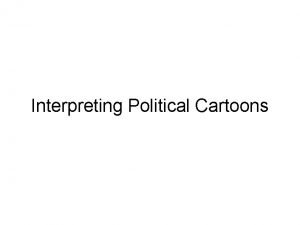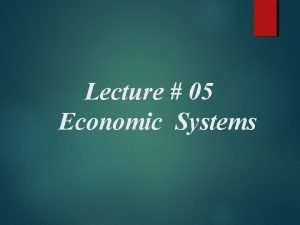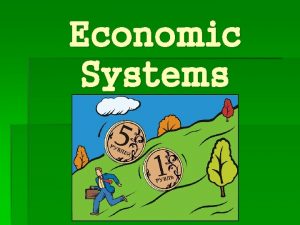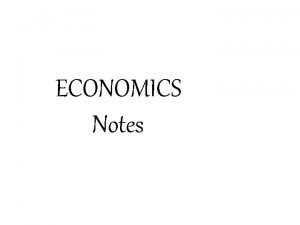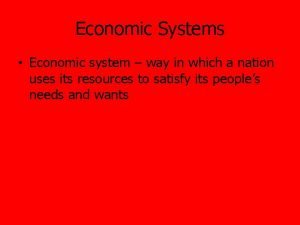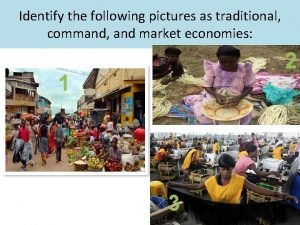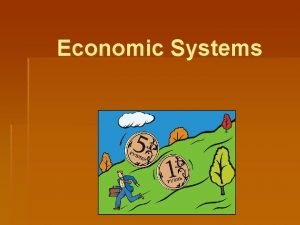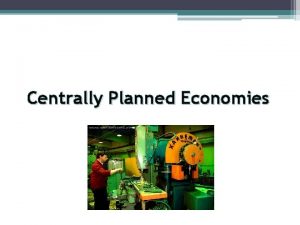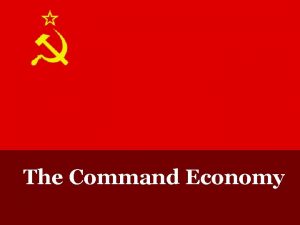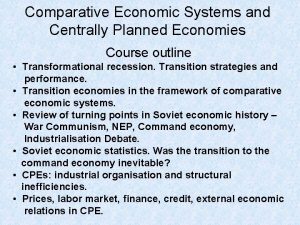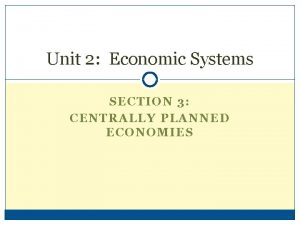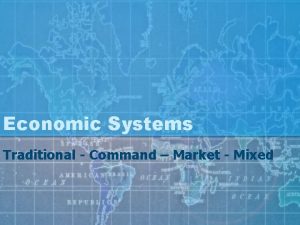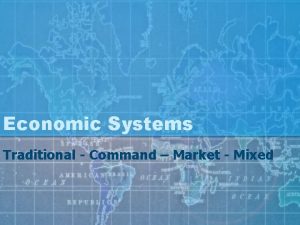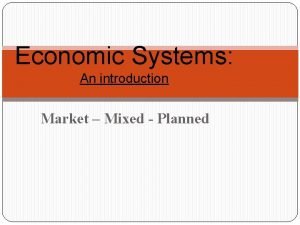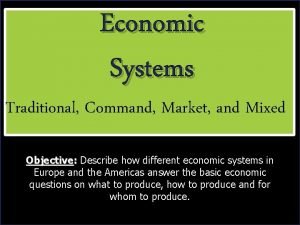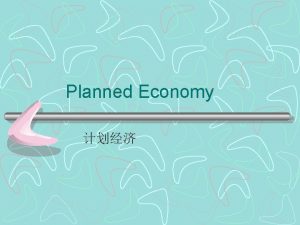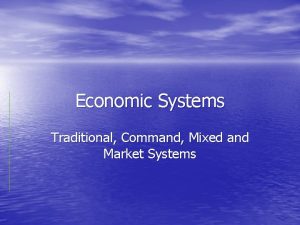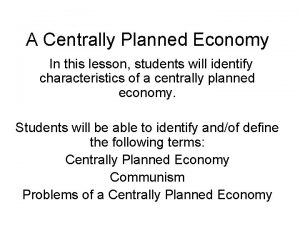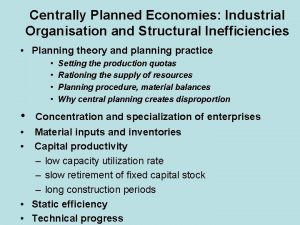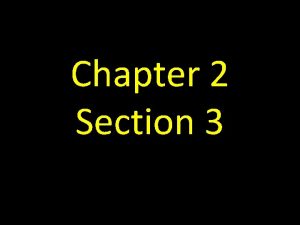Ch 2 ECONOMIC SYSTEMS Command Centrally Planned Mixed

















- Slides: 17

Ch. 2 - ECONOMIC SYSTEMS Command (Centrally Planned) Mixed Traditional Market

Ch. 2 - ECONOMIC SYSTEMS Today’s Objectives q I can contrast the different aspects of traditional, command, market, and mixed economic systems q I can categorize countries based on their economic system q I can differentiate nationalization and privatization q I can explain laissez-faire economics q I can evaluate the positive and negative elements of each economic system q I can categorize economic systems based on the amount of government involvement Traditional Command Market Mixed

Ch. 2 - ECONOMIC SYSTEMS Three Fundamental Economic Questions 1. What to Produce? The problem of scarcity imposes a restriction on the ability to produce everything we want during a given period. Guns vs. Butter

Ch. 2 - ECONOMIC SYSTEMS Three Fundamental Economic Questions 2. How to Produce? Vs. How do we mix technology and scarce resources in order to produce goods and services?

Ch. 2 - ECONOMIC SYSTEMS Three Fundamental Economic Questions 3. For Whom to Produce? Society must have a method to decide who will be “rich” and who will be “poor”.

Ch. 2 - ECONOMIC SYSTEMS 5 Economic Goals Economic Efficiency Making the most of resources Economic Freedom from government intervention in the Economic Freedom production of goods and services Economic Efficiency Assurance that goods and services will be available , Economic Security payments will be made time, and a safety net will Economic Security andon Predictability and Predictability protect individuals in times of economic disaster Economic Equity Fair distribution of wealth Economic Equity Economic Growth Innovation leads to economic growth, and economic Economic Growth andstandard Innovation growth leads to a higher of living and Innovation

Ch. 2 - ECONOMIC SYSTEMS Traditional Economies Relies on habit, or ritual to decide how to answer the 3 economic questions. • Revolves around the family • Work divided along gender lines • Slow to adopt new technology or ideas

Ch. 2 - ECONOMIC SYSTEMS Centrally Planned (Command) Economies The government owns both the land capital and decides on behalf of the people how to answer the 3 economic questions – requires absolute loyalty from the people • Communism - Government controls all aspects of production • Socialism – government owns some FOP – • Some private ownership of business in socialism Attempts to provide for everyone

Ch. 2 - ECONOMIC SYSTEMS Free Market Economies Individuals and privately owned businesses own the factors of production and decide how to answer the 3 economic questions • Specialization of tasks makes the economy more efficient • Everyone acts in their own self-interest • No government intervention • Laissez Faire – • French phrase to “leave things alone” or “hands-off” • Voluntary Exchange: a trade in which the parties involved anticipate that benefits will outweigh the costs

Ch. 2 - ECONOMIC SYSTEMS Mixed Economies Elements of traditional, command, and market economies - Most common economic system Traditional - Farming Market – Public Market Command – Highways

Ch. 2 - ECONOMIC SYSTEMS Mixed Economies The people answer the 3 economic questions with some intervention from the government to account for market failures • Economic decisions are made by individuals with government oversight • Government is a key component of economic activity • All nations exist in the “mixed economy continuum” Centrally Planned Free Market Iran N. Korea Cuba Sweden Russia France Peru United Kingdom Canada United States Singapore

Ch. 2 - ECONOMIC SYSTEMS Today’s Objectives q. I can differentiate nationalization and privatization q. I can explain laissez-faire economics q. I can identify the elements of the circular flow diagram q. I can evaluate how the factor and product market interrelate on the circular flow diagram Factor market Product market Households Businesses

Ch. 2 - ECONOMIC SYSTEMS Adam Smith’s Invisible Hand Self-interest and competition work together to regulate the marketplace Laissez-faire= hands-off government

Ch. 2 - ECONOMIC SYSTEMS

Ch. 2 - ECONOMIC SYSTEMS Circular Flow of Money ents ym r Pa acto F $ Factor Market $ wa inte ges, r e res t, p nt, rofi ts $ $ $ F. O. P L. L. C Households Businesses Supp ly $ $ s and Good es servic Product Market $ Expe nditu res $ $ nd a Dem

Ch. 2 - ECONOMIC SYSTEMS Modern Economies Privatization: National companies become privately owned Private companies become nationally owned

Ch. 2 - ECONOMIC SYSTEMS Modern Economies Privatization: National companies become privately owned Private companies become nationally owned Faster, Safer, and Cheaper transportation has led to an increased global economy
 Chapter 2 section 3 centrally planned economies answer key
Chapter 2 section 3 centrally planned economies answer key Centrally planned economy
Centrally planned economy Centrally planned economy
Centrally planned economy A wise economist asks a question
A wise economist asks a question Lesson 2 our economic choices
Lesson 2 our economic choices Mixed economic system
Mixed economic system Economic system mixed
Economic system mixed Centrally acting skeletal muscle relaxants
Centrally acting skeletal muscle relaxants Antihypertensives classification
Antihypertensives classification Centrally acting muscle relaxant
Centrally acting muscle relaxant What is command economic system
What is command economic system What is command economic system
What is command economic system Traditional economic system picture
Traditional economic system picture Economic growth vs economic development
Economic growth vs economic development Economic development vs economic growth
Economic development vs economic growth Africa's economic systems comprehension check answer key
Africa's economic systems comprehension check answer key Economic systems examples
Economic systems examples Command economy examples
Command economy examples

